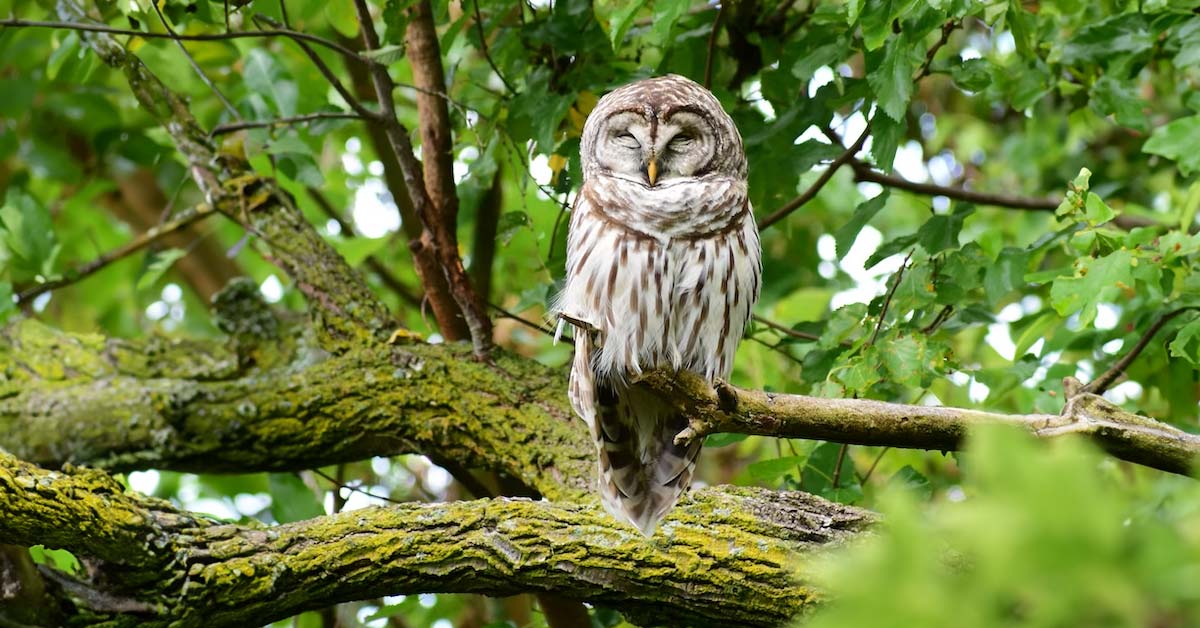Almost a dozen owls in Illinois exist, but not all of them are around throughout the year.
Some of the Illinois owls are actually not from around here, but either pass by or migrate during winter. Others are so rarely seen that they’re sometimes not counted as owls of Illinois.
If you’ve seen one of these gorgeous birds and need help identifying them, read on to learn all about these owls in Illinois (with pictures), the sound they make, and other cool trivia.
Owls in Illinois that Live there All Year
The Barred Owls, Eastern Screech-Owl, and Great Horned Owl are seen around parts of Illinois all year.
1. Barred Owls (Strix varia)
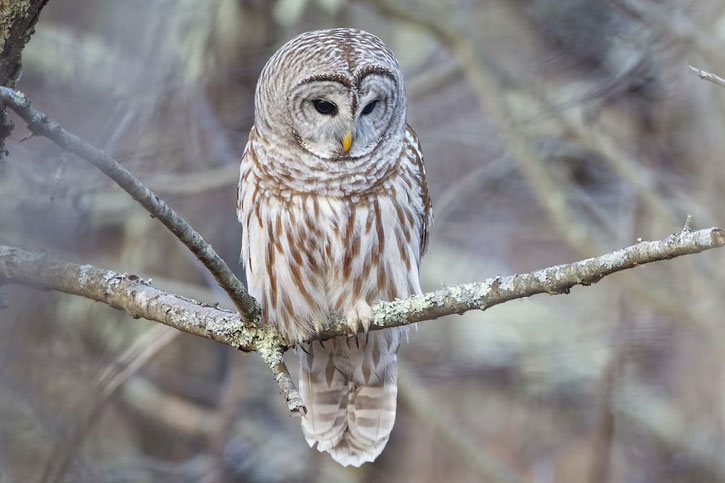
- Length: 16.9 to 19.7 inches
- Weight: 30 to 37 oz
- Wingspan: 16.6 to 43.3 inches
In Illinois, barred owls are permanent residents in swamps, upland woods, forests, conifers, and other wooded areas near water. They are very common and rarely travel.
Barred owls are also widespread in the eastern half of the country. They eat have a varied diet, feeding on their favorite mice, but also on small birds, insects, mammals, reptiles and crayfish or fishes if they’re near water.
2. Eastern Screech Owl (Megascops asio)
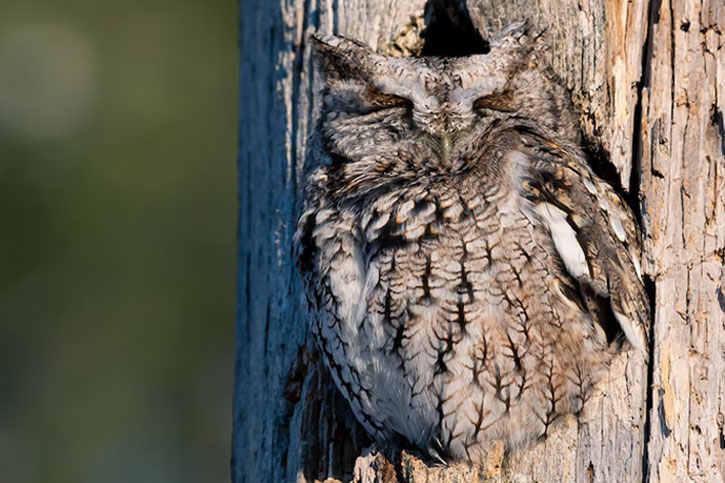
- Length: 6.3 to 9.8 inches tall
- Weight: 4.3 to 8.6 oz
- Wingspan: 18.9 to 24.0 inches
As their name suggests, the Eastern Screech-Owls are residents of the eastern part of the country. And since they do not migrate, you can find these owls in Illinois all year, mostly in parks, woods, and even in the suburbs as long as they are full of trees.
Eastern Screech-Owls eat insects, worms, bats, small mammals, and even small birds. They’re small (the size of a robin) and stocky birds, but they could pounce on their prey if one goes near the owl’s tree.
These owls are also known for their “screech” or the call that sounds like a whinny shrill.
3. Great Horned Owl (Bubo virginianus)
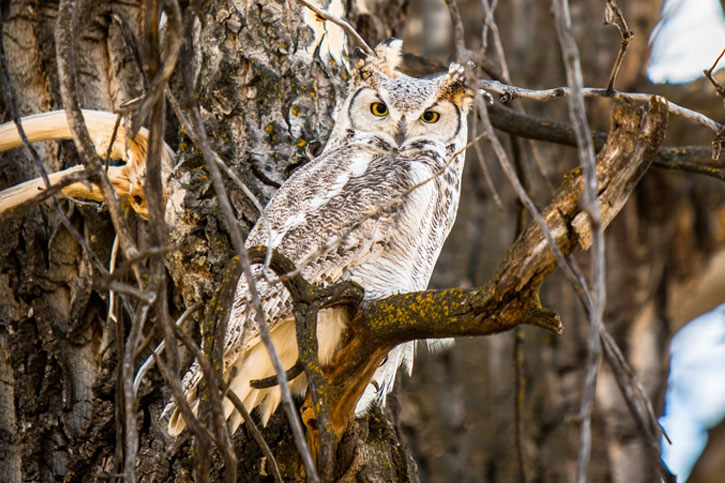
- Length: 18.1 to 24.8 inches tall
- Weight: 32.1 to 88.2 oz.
- Wingspan: 39.8 to 57.1 inches
Great Horned Owls are one of the most common owls in North America. It is also the largest owl in Illinois and 1 of only 3 owl species that are seen in the state all year-round.
It’s easy to spot this own because of their “great horns,” which technically are their ear tufts that look like a set of horns.
Great Horned Owls are found everywhere in Illinois from the city neighborhoods to the forest, as long as there are trees to nest in.
They feed on small frogs, jackrabbits, hares, geese, mice, skunks and other animals (even those larger than then). Great Horned Owls are also the biggest enemy of crows.
Owls that Migrate to Illinois during Winter
In the winter, owls like the Northern Saw-whet Owl, Snowy Owl, Short-eared Owl, and Long-eared Owl visit Illinois and take shelter in North America instead of other colder parts of the world.
4. Northern Saw-whet Owl (Aegolius acadicus)
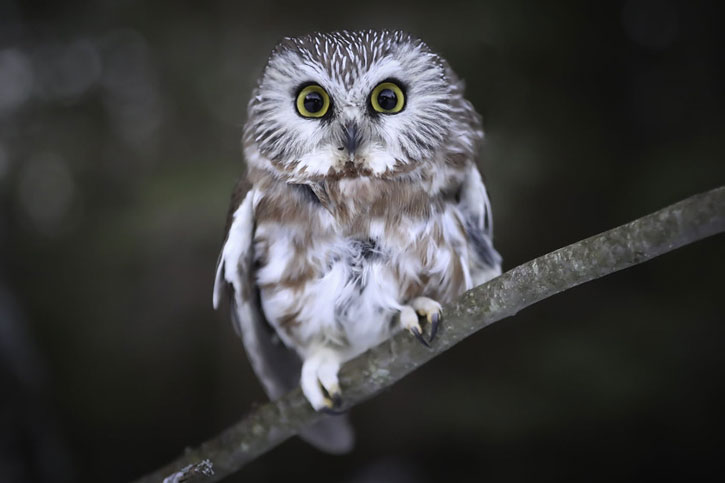
- Length: 7.1 to 8.3 inches tall
- Weight: 2.3 to 5.3 oz
- Wingspan: 16.5 to 18.9 inches
Northern Saw-whet Owls, small owls the size of a robin, visit north Illinois for the winter (usually from October to March). They prefer dense forests with a nearby water source, but these owls are rarely seen due to their nocturnal nature.
Northern Saw-whet Owls like to eat mice, squirrels, chipmunks, bats, or voles. They are famous for their high-pitched, urgent “hoo” calls that sound like they’re threatened.
5. Snowy Owl (Bubo scandiacus)
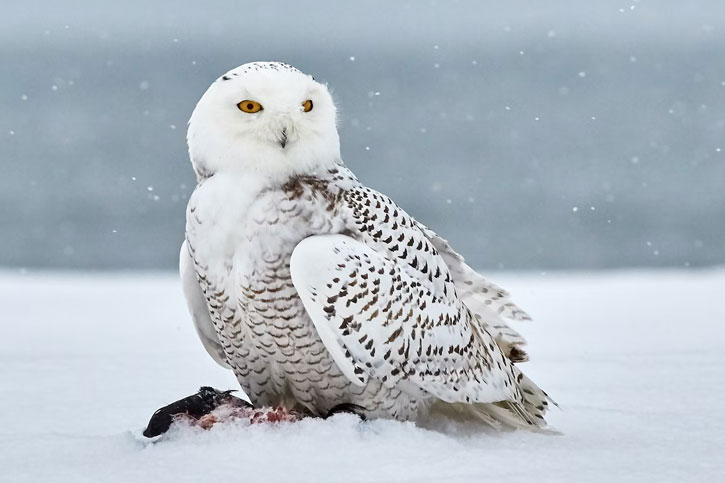
- Length: 20.5 to 27.9 inches tall
- Weight: 56.4 to 104.1 oz
- Wingspan: 49.6 to 57.1 inches
Snowy Owls aren’t permanent residents of Illinois, but they do spend some of their winters here (not every year though). As such, some people would be lucky enough to spot them sometime between October and May. And because they’re active during the day, unlike other owls, it is easier to spot them when they do pick an Illinois winter site.
Snowy Owls feed on smaller birds, waterfowl, rabbits, squirrels, rodents, ducks, geese and small mammals such as lemmings.
Also known as White Owl or Arctic Owl, the Snowy Owls have a distinct, raspy “hoo!” sound.
6. Short-eared Owl (Asio flammeus)
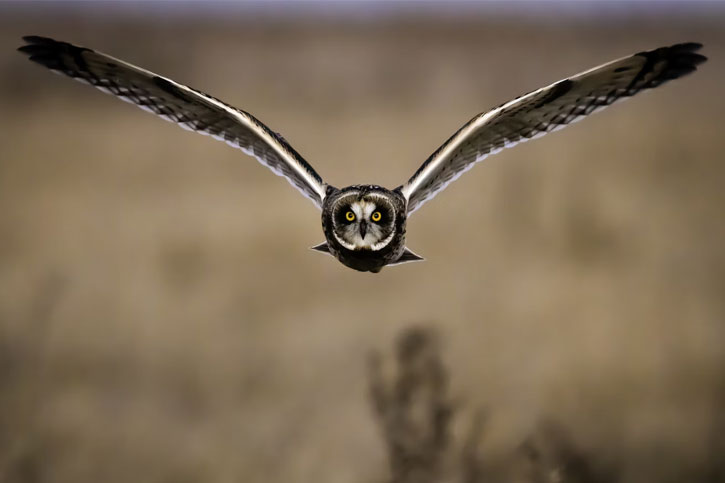
- Length: 13.4 to 16.9 inches tall
- Weight: 7.3 to 16.8 oz
- Wingspan: 33.5 to 40.5 inches
As their name suggests, Short-Eared Owls have super-short ear tuffs that are actually only visible when they’re threatened or become defensive.
Short-Eared Owls are one of Illinois’ winter birds, which means they’re only spotted in the central and southern parts of the state between October and April. During this period, they stay in grasslands, open fields, tundra, dunes and other uninhabited areas.
Short-Eared Owls hunt for shorebirds, gulls, voles, and small mammals.
7. Long-eared Owl (Asio otus)
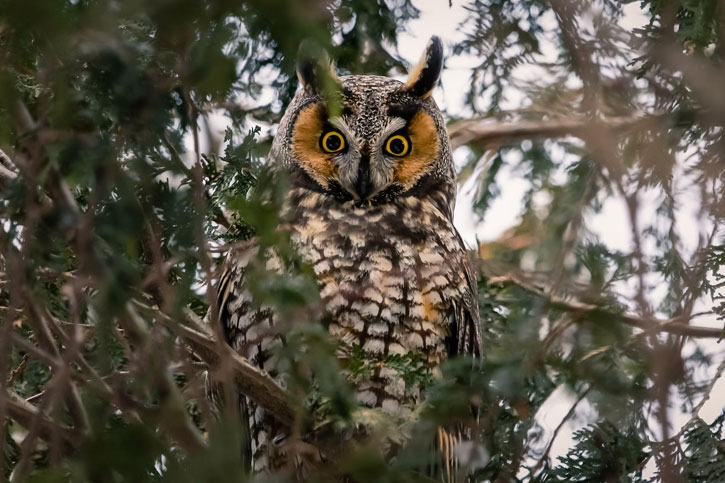
- Length: 13.8 to 15.8 inches tall
- Weight: 7.8 to 15.3 oz
- Wingspan: 35.4 to 39.4 inches
Long-eared Owls breed in northern US states, but migrate to Illinois and other parts of the country for winter. When they visit, they stay in wooded areas with dense trees near open areas for hunting.
Aside from their “long ears,” these owls are easier to identify thanks to their surprised look.
Long-eared Owls hunt for small birds, mice, voles, rabbits, and other small mammals.
Rare Owls in Illinois
Northern Hawk Owl, Boreal Owl, Barn Owl, and Burrowing Owl are very rarely spotted in Illinois, but they are either hiding or prefer spots with few human interaction.
8. Northern Hawk Owl (Surnia ulula)
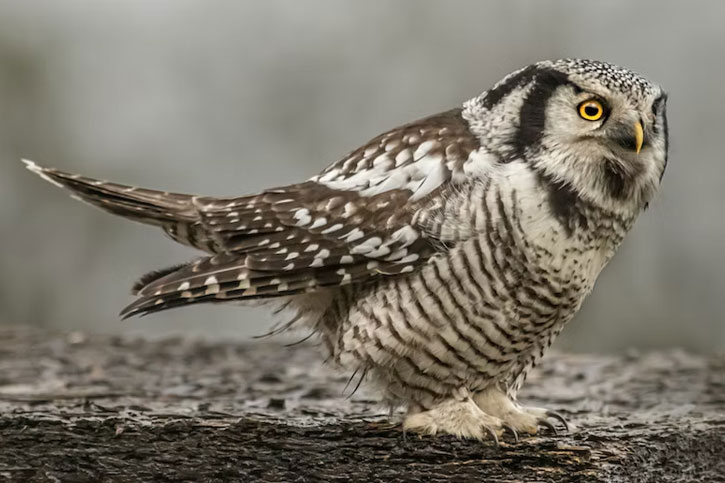
- Length: 14.5 to 17.5 inches tall
- Weight: 10.5 oz
- Wingspan: 33 inches
Northern Hawk Owls are super rare, but they are known to be found in the far northern part of Illinois during winter. They prefer to stay in abandoned nests or woodpecker holes, open tree stumps, as long as the spot is near a water source.
Unlike many other owls in Illinois, Northern Hawk Owls hunt in daytime. They feed on mammals, usually hunting for voles, but also eat smaller birds like grouse.
Northern Hawk Owls are named as such due to their hawk-like appearance.
9. Boreal Owl (Aegolius funereus)
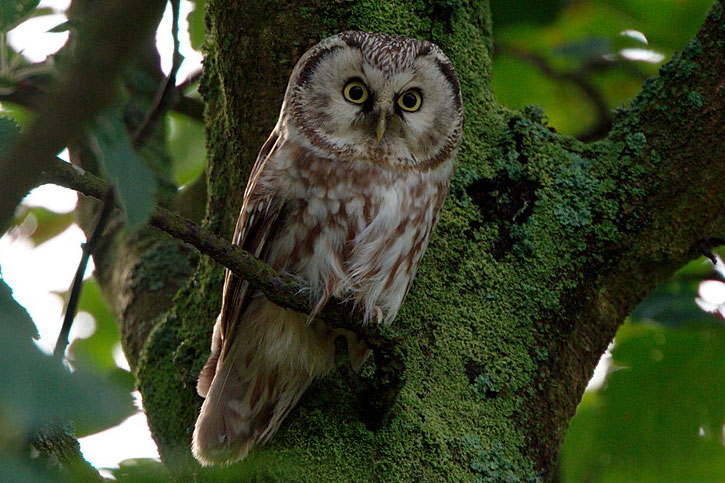
- Length: 9 to 10 inches tall
- Weight: 3.6 oz
- Wingspan: 20 to 26 inches
Boreal Owls are extremely rare in Illinois, but they have been seen in the state as well. These small owls with a predominantly large square head prefer to live in high-elevation forests or mountains atop trees like fir, birch, spruce, etc.
And because Boreal Owls hunt insects, birds, voles, squirrels, bats, frogs, mice, and other small mammals at nighttime, they are rarely spotted by people.
Boreal Owl calls are either short hoo’s or a series of “whistled “toots.”
10. Barn Owl (Tyto furcata)
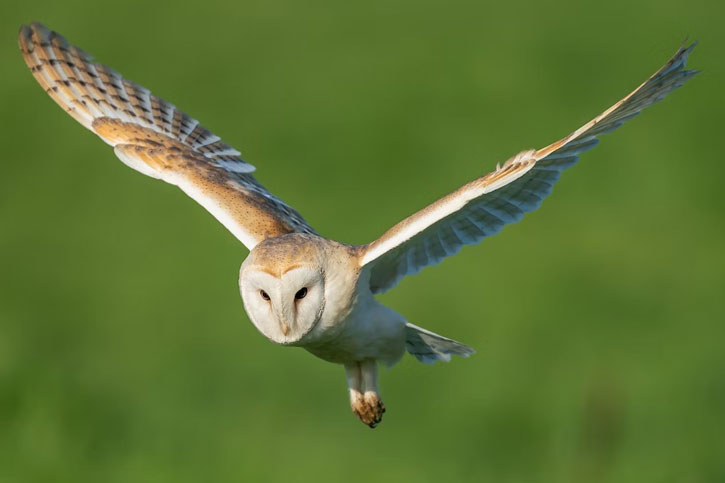
- Length: 12.6 to 15.8 inches tall
- Weight: 14.1 to 24.7 oz
- Wingspan: 39.4 to 49.2 inches
Barn Owls are very easy to identify because of their white-colored heart-shaped face and contrasting dark eyes, but they are considered accidental, rare and endangered species in Illinois. If you’re trying to spot one, they are mostly in the southern part of Illinois. They prefer to stay in the edges of forests, abandoned fields, and even buildings, as long as they can find cave- or cavity-like nests.
However, Barn Owls are strictly nocturnal and hunt mostly by sound thanks to their impeccable sense of hearing. They prey on insects, lizards, rats, bats, voles, rabbits, lemmings and even small birds. Barn Owls are known to swallow their entire prey whole, then cough up their bones, fur, or other inedible parts throughout the day.
Barn Owls also don’t hoot. Their calls is considered more of a screech instead.
11. Burrowing Owl (Athene cunicularia)
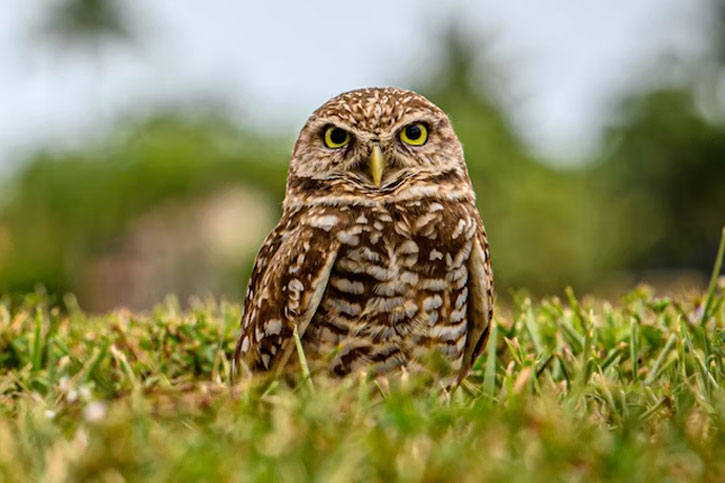
- Length: 9 to 11 inches tall
- Weight: 5.3 oz
- Wingspan: 20 to 24 inches
Burrowing Owls are so rare in Illinois that the last time they were spotted was in 2015 around La Salle. They’re known to stay in agricultural areas, open grasslands, prairies or deserts, since they usually nest underground, in fallen trees, or as their name suggest, in prairie dog burrows. Burrowing Owls also tend to perch on fence posts.
Burrowing Owls hunt everywhere, both in daytime and nighttime. They can wade through shallow water, fly or run on land, wherever they could find rats, bats, mice, gophers, rabbits, lizards, and even smaller birds that they could pounce on.
Owl-sighting in Other Towns?
If you’re on a journey to see as much owls as you can in your lifetime, I’ve written other guides about owl-viewing in the past. Check them out here:
Owls are also considered scavengers that help the environment get rid of waste and remains of smaller, dead animals. Check this out for info on other, super-helpful scavenger birds.
